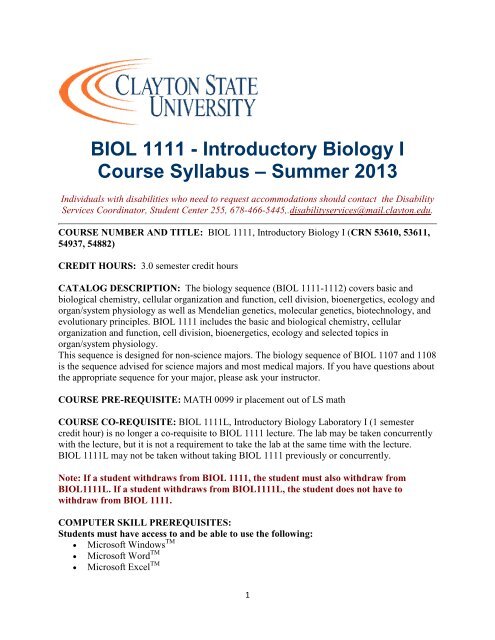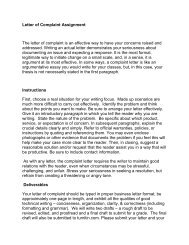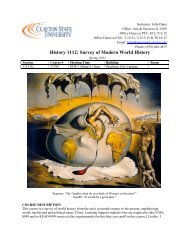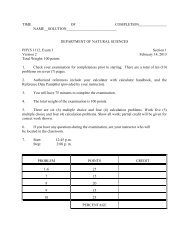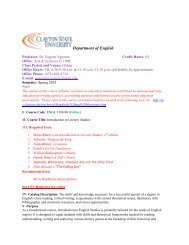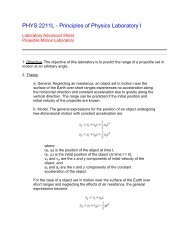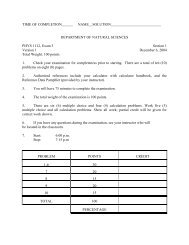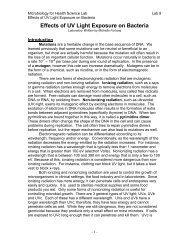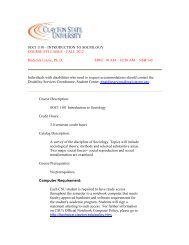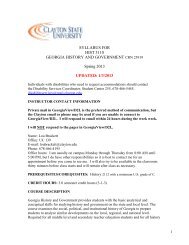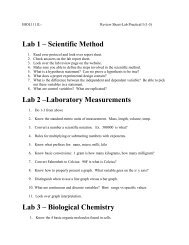Bio1111Summer 2013 syllabus.pdf - Clayton State University
Bio1111Summer 2013 syllabus.pdf - Clayton State University
Bio1111Summer 2013 syllabus.pdf - Clayton State University
You also want an ePaper? Increase the reach of your titles
YUMPU automatically turns print PDFs into web optimized ePapers that Google loves.
BIOL 1111 - Introductory Biology ICourse Syllabus – Summer <strong>2013</strong>Individuals with disabilities who need to request accommodations should contact the DisabilityServices Coordinator, Student Center 255, 678-466-5445,.disabilityservices@mail.clayton.edu.COURSE NUMBER AND TITLE: BIOL 1111, Introductory Biology I (CRN 53610, 53611,54937, 54882)CREDIT HOURS: 3.0 semester credit hoursCATALOG DESCRIPTION: The biology sequence (BIOL 1111-1112) covers basic andbiological chemistry, cellular organization and function, cell division, bioenergetics, ecology andorgan/system physiology as well as Mendelian genetics, molecular genetics, biotechnology, andevolutionary principles. BIOL 1111 includes the basic and biological chemistry, cellularorganization and function, cell division, bioenergetics, ecology and selected topics inorgan/system physiology.This sequence is designed for non-science majors. The biology sequence of BIOL 1107 and 1108is the sequence advised for science majors and most medical majors. If you have questions aboutthe appropriate sequence for your major, please ask your instructor.COURSE PRE-REQUISITE: MATH 0099 ir placement out of LS mathCOURSE CO-REQUISITE: BIOL 1111L, Introductory Biology Laboratory I (1 semestercredit hour) is no longer a co-requisite to BIOL 1111 lecture. The lab may be taken concurrentlywith the lecture, but it is not a requirement to take the lab at the same time with the lecture.BIOL 1111L may not be taken without taking BIOL 1111 previously or concurrently.Note: If a student withdraws from BIOL 1111, the student must also withdraw fromBIOL1111L. If a student withdraws from BIOL1111L, the student does not have towithdraw from BIOL 1111.COMPUTER SKILL PREREQUISITES:Students must have access to and be able to use the following: Microsoft Windows TM Microsoft Word TM Microsoft Excel TM1
StyleDescription: Given that most exams in this course are multiple choice in format, there is nosignificant evaluation of style, other than proper bubbling of scantron forms.Evidence: Scantron forms are checked by students for scanning errors. Any detected arereported to the instructor. Critical thinking: all components (question/issue, method, evidence, conclusion). BIOL1111 will require application of knowledge base information to understand biologicalrelationships.Question/IssueDescription: Given student unfamiliarity with biological concepts, the instructor in allintroductory biology courses generally provides the question/ issue component. Students areencouraged to ask questions about biological concepts.Evidence: None.MethodDescription: Given an instructor provided question, students are required to determineappropriate biological concepts to address the problem at hand.Evidence: Samples of student work on examinations.EvidenceDescription: Non-quantitative critical thinking is evaluated through conceptual multiple-choicequestions or short answer questions.Evidence: Samples of student work on examinations.ConclusionDescription: Conclusions that are biologically correct and reasonable are required.Evidence: Samples of student work on examinations.TEACHER EDUCATION STANDARDS:Conceptual Framework:The mission of the Teacher Education Unit is to prepareprofessional educators who engage in reflective practice and whoare competent, caring, committed, collaborative, culturallyresponsive, and prepared to teach diverse learners in an everchangingsociety.The content of this course <strong>syllabus</strong> correlates to education standardsestablished by national and state education governing agencies, accreditingagencies and learned society/ professional education associations. Please referto the course correlation matrices located at the following web site:http://www.clayton.edu/teachered/standardsoutcomes3
INSTRUCTOR INFORMATION:Dr. Samantha Fowler (CRN 53610)Office: NBS 165Phone: (678) 466-4816email: SamanthaFowler@clayton.eduInternet address: http://faculty.clayton.edu/sfowler4Office Hours: http://faculty.clayton.edu/sfowler4/scheduleDr. Diane Day (CRN 53611)Office: NBS 146Phone: (678) 466-4794Fax: (678) 466-4899E-mail: DianeDay@clayton.eduHomepage: http://faculty.clayton.edu/dday2Office Hours:Renee McFarlane (CRN 54937)Office: NBS, Room 158Phone: (678) 466-4790Fax: (678) 466-4797Email: ReneeMcFarlane@clayton.eduInternet: http://faculty.clayton.edu/rmcfarlaOffice Hours:Dr. J. Yvette Garner (CRN 54882)Office: NBS, Room 166Phone: (678) 466-4779Fax: (678) 466-4797Email: Jgardner@clayton.eduInternet: http://faculty.clayton.edu/jgardnerOffice Hours:CLASS MEETINGS:Section CRN Days Times Room Instructor1 53610 TR 8:00 am – 10:05 am U265 Fowler2 53611 MW 3:30 – 5:35 pm B11 Day4 53611 MW 6:00 pm - 8:05 pm 126 McFarlane9 54882 Gardner4
Notes on course number 54882:This is an online course designed for the distant learner with the computer literacy skills requiredto operate Georgia View Desire to Learn and the Bioportal that accompanies the text for thecourse (Biology for a Changing World by Shuster). Please take a look at the <strong>syllabus</strong> for the<strong>2013</strong> Summer Session at http://faculty.clayton.edu/jgardner. Only 1 mandatory orientation willoccur during the summer session which will be at 11 am on Saturday, May 18, <strong>2013</strong> in NBS 126.Failure to attend the orientation will result in a No Show for the course. This orientation willcover how to operate the Bioportal, submit assignments, exam dates, review of the <strong>syllabus</strong>, andweekly online office hours. All exams will be online including the final exam which will be July27, <strong>2013</strong>. Entrance into this course requires Departmental Approval. The process for gettingapproval can be found here: http://www.clayton.edu/science/online. Contact Dr. Gardner atjgardner@clayton.edu for questions.TEXTBOOK INFORMATION: Shuster, M., J. Vigna, G. Sinha, & M. Tontonoz. Biologyfor a changing world with Core Physiology. WH Freeman and Scientific American 2012.ISBN: 978-1429297028Chapters to be covered: 1-13EVALUATION:ItemPoints3 tests @ 100 points 300Quizzes/Assignments 1001 Cumulative Final Exam 100Total 500GRADING:Your final grade will be determined as follows:GradePercentageA 90 – 100%B 80 – 89%C 70 – 79%D 60 – 69%5
F Below 60%TENTATIVE COURSE SCHEDULE*:Week Date Topic Chapters1 May 22-21Introduction, Process ofScience11 May 22-23Chemistry and Molecules ofLife22 May 27May 28-29HOLIDAYCell Structure and Function32 May 31June 1Cell Structure and FunctionMake up Day for Monday333 June 3-4 Exam I3 June 5-6 Nutrition, Metabolism,Enzymes44 June 10-11Energy Flow andPhotosynthesis54 June 12-13Energy and Cell Respiration65 June 17-18Exam II6
5 June 19-20 DNA 7Last Day to Drop w/o Academic Penalty: Friday, June 216 June 24-25Gene to Protein86June 26-27June 28MitosisMake up day for July 4th997 July 1 Mutations and Cancer 107 July 2-3July 4thMeiosis & single geneinheritanceHOLIDAY118 July 18-9 Exam III8 July 10-11 Complex inheritance 129 July 15-16 Complex inheritance 129 July 17-18 Stem cells 1310 July 22-23 Review10 July 24-25 FINAL EXAM All above*This lecture schedule is tentative and may change. Tests may be given the week before or theweek after the week listed here--or during the week predicted. Specific test dates will beannounced approximately one week in advance in class.7
Classroom regulations and policies:Students must abide by policies in the <strong>Clayton</strong> <strong>State</strong> <strong>University</strong> Student Handbook, and the BasicUndergraduate Student Responsibilities.1. No electronic devices, including computers, cellular telephones, instant messaging devices,etc. with express permission from the instructor.2. No talking while the instructor or another student is talking. Students repeatedly violatingthis policy will be asked to leave the classroom for being disruptive.3. Snacks and drink are allowed, within reason. If you make a mess, you are responsible forcleaning it up.4. Visitors are not permitted without the instructor’s permission. Children are not allowed inthe classroom at anytime.5. Quizzes may be given at any time during the class. Students who are not present in the roomwhen the quiz is being handed out must remain outside of the classroom until the quiz is finishedand will receive a grade of zero. There are no make-up quizzes. The lowest quiz grade will bedropped.6. Exams (Tests) start at the beginning of class. Students who are more than 10 minutes late willnot be allowed to begin the exam. There are no make-up exams. Your lowest test grade may bereplaced with your final exam grade, if the final exam grade is higher.7. Assignments are due at the start of class on the due date listed in the schedule. Assignments maybe turned in early. Late assignments will receive a grade of zero.8. Attendance is expected. You are responsible for obtaining any missed information from otherstudents. This includes information concerning quiz dates, exam dates, due dates, etc. Studentswho do not attend regularly generally do not do well in the course. There are no "excusedabsences" in this class. Any quiz, exam, or assignment that was missed will receive a grade ofzero.9. No form of academic dishonesty will be tolerated in this course. The most common forms arecheating and plagiarism, but any type of activity that is considered dishonest by reasonablestandards will constitute academic dishonesty. The minimum penalty is a grade of zero on thework involved. The maximum penalty is expulsion from the university. Be aware that studentsfound in violation of the university’s academic dishonesty code have lost scholarships, athleticeligibility, and/or their U.S. student visa (if an international student). All forms of academicdishonesty will be reported to the Office of Student Affairs for investigation. Judicial proceduresare described at http://www.clayton.edu/Portals/47/docs/discipline.<strong>pdf</strong>.10. No form of disruptive behavior will be tolerated in this class. While a variety of behaviorscan be disruptive in a classroom setting, more serious examples include belligerent, abusive,profane, and/or threatening behavior. A student who fails to respond to reasonable facultydirection regarding classroom behavior and/or is found to be repeatedly disruptive whileparticipating in classroom activities may be dismissed from class. A student who is dismissed isentitled to due process and will be afforded such rights as soon as possible following dismissal. Iffound in violation, a student may be administratively withdrawn and may receive a grade ofWF. For more information, please refer to:http://as.clayton.edu/DisruptiveClassroomBehavior.htmCommon examples of disruptive behavior include, but are not limited to:a. Monopolizing classroom discussionsb. Failing to respect the rights of other students to express their viewpointsc. Talking when the instructors or other students are speakingd. Constant questions or interruptions which interfere with the instructor’s presentation8
e. Overt inattentiveness (e.g. sleeping or surfing the internet)f. Creating excessive noiseg. Entering the class late or leaving the class earlyh. Use of cell phones or pagers in classi. Inordinate or inappropriate demands for time or attentionj. Poor personal hygiene (e.g. noticeably offensive body odor)k. Refusal to comply with faculty directionStudents exhibiting these types of behaviors can expect a warning from the instructor or dismissal forthe lesson in which the behavior occurs. Failure to correct such behaviors can result in dismissal fromthe course.More extreme examples of disruptive behavior include, but are not limited to:a. Use of profanity or pejorative languageb. Intoxicationc. Verbal abuse of instructor or other students (e.g. taunting, badgering, intimidation)d. Harassment of instructor or other studentse. Threats to harm oneself or othersf. Physical violenceStudents exhibiting these more extreme examples of disruptive behavior may be dismissed from thelesson or the entire course.Students dismissed from a lesson will leave the classroom immediately or may be subject toadditional penalties. Dismissed students are responsible for any course material or assignmentsmissed.Students dismissed from a course have the right to appeal the dismissal to the department headresponsible for the course. Appeals beyond the department head may also be pursued. If no appeal ismade or the appeal is unsuccessful, the student will receive a grade of WF (withdrawal – failing)regardless of the current grade in the course.Conditions attributed to physical or psychological disabilities are not considered as a legitimateexcuse for disruptive behavior.The description of disruptive behavior and listings of examples of disruptive behavior are taken fromthe Web sites of James Madison <strong>University</strong>, the <strong>University</strong> of Delaware and Virginia Tech.Changes or additions to this <strong>syllabus</strong>, including reading, exam schedule, grading, and coursepolicies can be made at the discretion of the instructor at any time.Last update: 4/29/<strong>2013</strong>9


